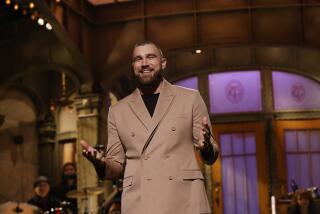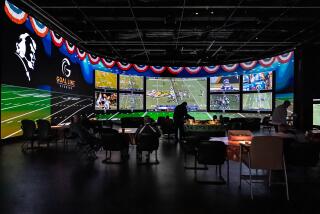10 Years on Road to Glory : Football: The AFL took root in 1960 and quickly was maligned. But by 1970, it had become a thorn deep in the side of NFL.
They were born the Los Angeles Chargers in 1960, and they were one of eight charter members of what lived for 10 years as the American Football League. They were born winning.
In that difficult first season, the Chargers, with Sid Gillman coaching, won 10 of 14 regular-season games to finish first in their division.
But Los Angeles wasn’t interested. When the turnout for the club’s third home game was even smaller than earlier crowds--which had averaged fewer than 5,000 in the 100,000-seat Coliseum--a Charger assistant, Jack Faulkner, approached Gillman with a suggestion.
“Let’s save some time today,” Faulkner said as they stood glumly on the sideline shortly before the kickoff. “Instead of announcing the starting lineups, let’s just send the players up into the stands to shake hands with the crowd.”
A few months later, the AFL saw Faulkner’s point.
As the Chargers prepared for the AFL’s first title game at the Coliseum--against the Eastern champion Houston Oilers--the site was abruptly changed to Houston.
“It’s in our best interests,” said AFL Commissioner Joe Foss.
Gillman and Charger owner Barron Hilton agreed, even though it cost them the home-field advantage and possibly the game.
“The (Chargers) had already lost $900,000,” Gillman recalled at his home here recently. “The Coliseum is a historic place, but in those days, playing the championship game in a new league, we made more money on a high school field in Houston than we could ever make in the Coliseum.”
That was the AFL in 1960.
That’s how it was at the start of the AFL decade--1960-69--when, as the NFL doubled up laughing, the new league was commonly referred to as “the other league.”
No more.
No more jeers. And no more AFL--although, at the end of the AFL decade, it was the NFL that sued for peace, taking in all 10 of the other league’s clubs. As former AFL quarterback Joe Namath said from his home in Florida, “We had the last laugh.”
So in 1990, AFL buffs are celebrating two anniversaries:
--It was 30 years ago that their league was founded by a tough young Texan, Lamar Hunt, who still owns the Kansas City Chiefs. In cooperation with his equally ambitious partners, Hunt proved that with persistence, skill and luck, a group as ornery as the NFL of the 1960s can be had.
--It was 20 years ago that the two leagues completed the merger that forged the modern NFL that included, among other things, the Super Bowl.
The Super Bowl is here because, although the NFL wanted nothing to do with the other league, the AFL insisted on playing it. AFL founder Hunt even gave it its name.
By 1970, the AFL, renamed the American Football Conference and joined by the Pittsburgh Steelers, Baltimore Colts and Cleveland Browns, had become the stronger half of the merged NFL. Teams representing AFL and AFC franchises won 11 Super Bowls in the first 13 years after the Green Bay Packers won the first two in 1967 and ’68.
The AFL-NFL merger wasn’t universally applauded, however. It was bitterly opposed by many of those who lived and died with the AFL.
From Buffalo to Oakland, there were, by the late 1960s, thousands of anti-NFL, pro-AFL fans.
By then, it was obvious that the NFL was crying uncle. When Al Davis, the last AFL commissioner, began luring NFL quarterbacks, it was obvious that the NFL’s club owners had been outmaneuvered.
The change from the AFL’s first season was breathtaking.
In 1960, Lamar Hunt had begun operations as unsteadily as the founder of any other league, losing Los Angeles quickly, and almost New York.
In the West, the Chargers, although they hit the divisional title target with their first shot, were obliged to flee after the 1960 season to San Diego.
In the East, things looked worse. The owner of the New York franchise, Harry Wismer, could only afford one place for a box office--the dining room of his own apartment.
As Hunt tells it, he approved that piece of daffiness simply because the apartment was on Park Avenue. What Hunt didn’t know--what few knew--was that the only entrance to the Wismer building was on 48th Street, where hardly anyone could find it.
A day or two before the first AFL game, one persistent New York fan finally located the right elevator and then the right apartment, and he was met at the apartment door by Wismer’s blonde maid, who spoke Swedish but not much English.
“It was the AFL’s first crisis, and we blew it,” Hunt said. “The maid was getting Wismer’s dinner on the table and couldn’t be bothered selling tickets.”
THE BABY-SITTERS
The AFL team that became the Kansas City Chiefs, winning Super Bowl IV under Coach Hank Stram, began as the Dallas Texans and played in Hunt’s hometown for three years.
Stram said he will never forget the first year, when the Texans, scheduling a tryout camp, attracted hundreds of bartenders, cowboys and others who thought they could play football.
Wondering how to cut them to a manageable number, Stram noticed that club owner Hunt had brought his warm-up shorts to camp and was getting set to work out himself, starting with the 40-yard dash.
When he ran it in 5.1 seconds, Stram was inspired.
“Hey, you receivers and backs,” Stram yelled. “We’re cutting everybody that can’t run faster than the owner.”
If that’s how Stram and Hunt put their first-year team together, the job soon got more difficult.
The NFL saw to that, launching a spring campaign to corner the rookie talent market. In the week of the draft, NFL scouts identified the nation’s top 25 college players and assigned 25 staff employees to watch over them.
Known as baby-sitters, these staffers used remote hotels and resorts, for the most part, as places to stash the players, keeping them away from AFL teams until NFL teams could draft and sign them.
One day, when Hunt broke through a cordon of baby-sitters and made long-distance contact with a college quarterback, Roman Gabriel, he was dismayed but not put off by the young prospect’s hourlong effort to get a full disclosure of AFL plans for high choices.
As Hunt recalls, Gabriel, on the telephone from his college room, would ask: “What’s the biggest signing bonus you’re prepared to offer a quarterback?”
And Hunt would reply: “I really shouldn’t say, but for a great one such as yourself, we can go high (as $25,000).”
Years later Hunt learned that he had never actually talked with Gabriel. The voice on the phone in his room was that of Gabriel’s weekend guest, Elroy Hirsch, the inquisitive general manager of the Rams, who already had Gabriel under contract.
“It was like war,” Hunt said of that era. “And I think it made the AFL a viable league. The cloak-and-dagger stuff captured the public’s imagination.”
Hunt seemed personally miscast--much too easygoing to start a war, let alone run one. When he organized his league, Hunt, a former second-string pass receiver at Southern Methodist, was the self-effacing, 27-year-old son of a billionaire.
Thirty years later, he looks much the same. Slight, smiling, bespectacled, he projects none of the steeliness that has been underneath all along.
Nor was there anything remarkable about the way he founded the AFL. Sports promoters have been challenging the haughty NFL with new leagues for most of the century, most recently with the World Football League and United States Football League, among others. A 1940s challenger was the All-America Conference, which in the end contributed the San Francisco 49ers and Cleveland Browns to the NFL.
And in the NFL’s first 50 years, five American Football Leagues rose to fight the NFL.
Hunt’s was merely the fifth, but also the most distinctive. His was the one that lasted, and, in time, pried its way en masse into a greatly enlarged NFL.
It didn’t come easily.
Hunt became a league founder only because the NFL declined, in 1959, to sell him an expansion franchise for Dallas. The NFL that year had only 12 clubs.
But when Hunt formed the AFL in early 1960 with partners in seven other cities, the NFL hurriedly decided to expand after all.
The AFL called it Operation Sabotage.
First, the NFL created the Dallas Cowboys and put them in Hunt’s town, an attempt to break the new league by hurting the AFL founder where it hurt the most.
The NFL awarded the Cowboy franchise less than a year after telling Hunt that it wouldn’t expand to Dallas, or anywhere, under any circumstances.
Next, the NFL created the Minnesota Vikings, handing the franchise to Hunt’s Minneapolis partners and costing the AFL its only base in the Midwest.
As it happened, the AFL’s club owners were meeting in Minneapolis the day that the NFL outflanked them there. And at dinner that night, the New York owner, Wismer, looked across the table at the principal Minneapolis owner, Max Winter, and said, softly but distinctly, “Nice going, Judas.”
When Winter sprang to his feet, Wismer, as he told it later, ignored him and addressed the other owners.
“Boys, this is the last supper,” he said sourly.
THE TURNING POINT
At a poker game in Texas one night in 1961, one of the players, between deals, put an idle question to his neighbor, wealthy oilman H.L. Hunt.
“How long can that boy of yours afford to blow his money on a football league?” the friend said.
“How much he losin’?” Hunt said.
“ ‘Bout a million a year, I hear,” the man replied.
“That much?” Hunt said. “At that rate, I only give him another 100 years.”
They say in Texas that that’s the true version of a story going around in the early days when, reportedly, Lamar Hunt kept bailing out the AFL’s weaker owners.
The problem was most acute in New York, where Hunt needed to make a television impact.
Joe McGuff, a former Kansas City sportswriter, now the editor of the Kansas City Star, remembers Wismer was going broke but wouldn’t quit.
So AFL Commissioner Foss called a league meeting at New York’s Waldorf Hotel, and, having decided to force Wismer out, arrived from his Dallas office with a pack of incriminating files that would prove his case.
That was a blow to Wismer, a canny type who, buying time before confronting Foss, got the Waldorf bell desk on the phone.
According to McGuff, Wismer identified himself as Joe Foss, and, giving the bell captain Foss’ room number, explained that an emergency had developed and he had to return home.
He said he didn’t have time to come by and pick up his luggage, but to close the bags, send them to the airport and get them on a flight to Dallas. Then, promising a big tip, Wismer rang off.
When Foss found his room empty, he had to cancel the hearing.
That saved Wismer for a while. By 1963, however, his club was so far in the hole that the AFL took over and resold it to Sonny Werblin, the showman who brought in Joe Namath.
“Getting Werblin was the (AFL’s) turning point,” Hunt said.
Not until the 1964 television negotiations did that become clear. The order of events that winter:
--Negotiating for the NFL, Commissioner Pete Rozelle got CBS to triple its rights fees to $1 million per year per club--an unheard-of TV sports sum until then.
--At almost the same time, ABC dealt the other league what seemed to be a final blow, canceling the last season of its AFL contract. After four years, Hunt’s league, it seemed, was finished.
--But, in what has been called the worst television deal ever made, NBC contracted not only to take on the AFL but to pay each club $1 million a year, matching the NFL’s package.
“I still don’t believe it,” an AFL coach said at the time. “NBC could have had us for 15 cents, give or take a nickel.”
Today, Hunt sees it differently.
“NBC did the smart thing,” he said. “Most of our clubs needed big money from TV to compete with the NFL. It was a smart business move for NBC to have a strong AFL, and Werblin was the guy who made them realize that.”
Suddenly on a par, financially, with the older league, the AFL got another break when the NFL’s New York Giants signed an AFL kicker, Pete Gogolak, who had finished his option season at Buffalo.
Previously, the reserve-option restrictions of all clubs in both leagues had been honored. Indeed, AFL and NFL owners scrupulously avoided the inter-league raids that would have led to wage escalations.
College prospects were another matter. The competing clubs fought bitterly over All-Americans such as Billy Cannon--who was signed by both leagues--and Mike Garrett, who had always wanted to play for the Rams, but was coaxed into the AFL.
But the Gogolak signing was something new. The AFL then elected as commissioner Al Davis--who was hired to frighten the NFL.
That he did.
And from that moment on, peace was inevitable, although it came slowly. First, at the end of the 1966 season, came Super Bowl I. Next, interleague exhibitions in 1967. Then interleague regular-season games in 1970. And, finally, 10 years of cash indemnities.
As AFL representative to the peace commission, Hunt had committed his league to $18 million to NFL owners in the two-team areas, New York and the Bay Area.
The very idea enraged AFL partisans. Any indemnity was a needless gift, they charged, and one day a group of them got together in Dallas to honor Hunt.
They named him Bonehead of the Year.
THE UNDERDOGS
Near downtown Los Angeles, in a new auditorium called the Sports Arena, John F. Kennedy was nominated for the Presidency that summer in 1960. The Rams went to training camp with a new coach, Bob Waterfield.
Some of Los Angeles’ citizens were then talking about building more freeways. Meantime, they were still riding the red streetcars.
In Denver, the financially strapped AFL Broncos played football in second-hand uniforms, which they had purchased from a Copper Bowl college team.
The uniforms had arrived complete with vivid yellow socks that had vertical brown stripes. Candy stripes, they were called.
“The Denver team was embarrassed,” said AFL veteran Jack Faulkner, now a Ram executive. “The players even offered to pay for proper socks themselves but were turned down.”
When Faulkner moved to Denver in 1962 as the Bronco coach, he put first things first, building a bonfire on opening day and burning all the candy stripes.
“All but one pair,” he said. “We sent one sock to the Hall of Fame, and I kept one to hang up at Christmas.”
Within 10 years, however, the AFL was playing better football than the 50-year-old NFL.
The athlete who first demonstrated that was the $400,000 quarterback, Namath, one of the first since Babe Ruth to make a fortune playing a game.
With Namath as their leader, the AFL’s 1968 New York Jets went into Super Bowl III as an 18-point underdog and won, 16-7, against the NFL champion Baltimore Colts, who, 13-1 that season, had romped past such NFL powers as the Chicago Bears, Vikings, 49ers, Giants and Rams.
Namath had predicted victory, had even guaranteed it, but it was still difficult to grasp. In one afternoon, the Jets completely changed national perception.
In one afternoon, proving that AFL football was at least as good as NFL football, the Jets made the Super Bowl into what it is today.
Before Namath, most fans had agreed with Vince Lombardi, coach of the Green Bay Packers, that the AFL’s 10 teams were plucky but weak.
“(Super Bowl III) meant something else to me,” Namath said of the game. “I think of it as a win for all the underdogs of the world. A lot of them wrote me that year. They said: ‘If you could do it, I can do it.’ ”
And how did the Jets do it?
At his Carlsbad home, Gillman, a Hall of Famer talking about a Hall of Famer, said: “Namath came to the Super Bowl as the champion of a slightly better league. The AFL was playing a different and better game on offense and defense both.
“(AFL) owners wanted excitement, so the AFL threw the ball--and found that that’s the best way to win, too.
“To control the pass, our defensive coaches invented sophisticated modern blitzing. This gave the AFL a leg up when it began interleague play against the NFL.”
In the ‘60s, however, the differences weren’t immediately reflected by ticket sales. In the beginning, worried AFL owners often resorted to gimmick promotions. For example, Hunt’s team admitted every barber in town free of charge to one game 30 years ago.
“Most barbers are good conversationalists who have a lot to say,” Hunt said, recalling his first AFL season. “We wanted them talking about us.”
And they did.
“But unfortunately, our next crowd was even smaller,” he said. “The barbers bad-mouthed us all week.”
More to Read
Go beyond the scoreboard
Get the latest on L.A.'s teams in the daily Sports Report newsletter.
You may occasionally receive promotional content from the Los Angeles Times.










